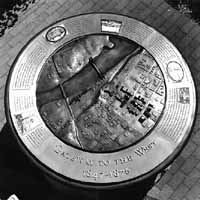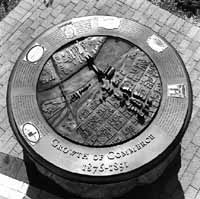The plaza walkway of the new Federal Reserve Bank of Minneapolis was completed this summer with the installation of five bronze interpretive exhibits that trace the history of the Mississippi riverfront. Designed by Helmuth, Obata and Kassabaum, St. Louis, the exhibits were fabricated by Gruppo Inc., Minneapolis.
 A Great Waterfall 1805
A Great Waterfall 1805
Long before the arrival of Europeans, the Mississippi riverfront was
home to Native Americans, largely Dakotas and Ojibwes. In 1680, while
exploring the Upper Mississippi Valley, Franciscan priest Louis Hennepin
came upon the falls and named them after St. Anthony. Although geology
and engineers have reshaped the river and the falls, this model depicts
the area as it was in about 1805.
 Gateway to the West 1847-1876
Gateway to the West 1847-1876
In 1854 a wooden toll bridge, the first permanent structure to span
the Mississippi, was built to connect the village of St. Anthony and
the city of Minneapolis. In 1872 St. Anthony and Minneapolis merged,
and the following year a new city hall was built in Bridge Square,
across the street from the bank site. As pictured in this 1875 scene,
the Federal Reserve bank site already contained a number of buildings,
and the riverfront area was known for its flour, lumber, wool and
paper mills.
 Growth of Commerce 1876-1891
Growth of Commerce 1876-1891
In 1876 the city of Minneapolis built a new suspension bridge across
the Mississippi. At the same time the mill district mushroomed, and
Minneapolis' population grew to 47,000. The Fed's corner became a
thriving commercial spot, adjacent to ribbons of James J. Hill's Great
Northern railroad tracks. Hill built the Union Depot across from the
Fed site in 1885 to serve his booming passenger and freight railroad.
 Civic Improvements 1891-1965
Civic Improvements 1891-1965
In 1891 another new bridge was built across the river, and the Fed's
neighborhood continued its transformation from the city's commercial
heart to its rail center. Completed in 1913, the Great Northern Depot
occupied a large part of the Minneapolis Fed's site. This 1925 depiction
also shows Bridge Square cleared of all buildings but the Gateway
Pavilion, constructed by the city in 1914 as part of a civic improvement
campaign.
 Transformations 1965-1995
Transformations 1965-1995
In this 1995 view of the Fed site, office and residential towers stand
out. Some older buildings had been renovated for new uses as artist
studios, shops and restaurants. The district surrounding the Falls
of St. Anthony was named to the National Register of Historic Places.
The Great Northern Depot was demolished in 1978, when the new Amtrak station was built in St. Paul,
and in 1990 the current Mississippi River bridge was built, designed to recall the first two bridges at this site. Prior to the construction of the Minneapolis Fed, only six buildings remained on the block; all were removed but the Market Hotel, built in 1888 and renovated as commercial space.




